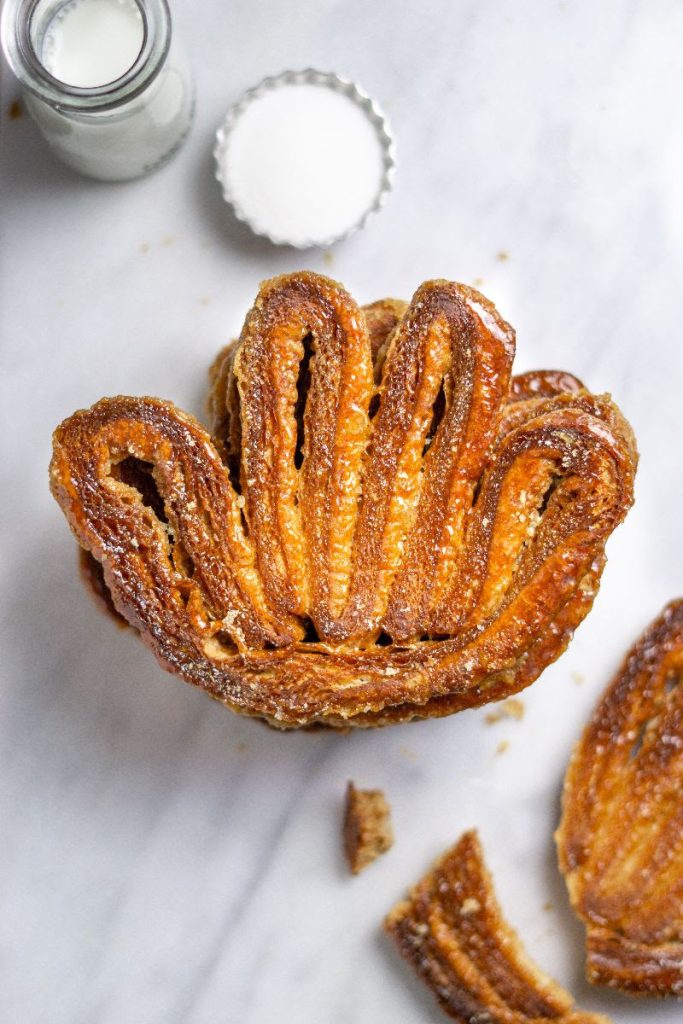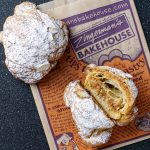Excerpt from Ari’s Top 5 enews
Freshly milled flour done on-site takes already good to really great!

There’s something so simple, and yet, simultaneously special about a palmier. Crunchy sweetness. Compelling caramelization of sugar. A whole bunch of butter. The palmier is a pastry that approximates what you would get if you took the best parts of the buttery crunch of a croissant’s flaky, crunchy crust, add a bunch of sugar, and then baked it without a lot of surface area so most all of what you end up is lovingly caramelized by that magical Maillard effect. A palmier, I’m thinking, is something someone ought to write poetry about.
Palmiers are made from what bakers will know as “laminated dough,” similar in style to the croissant, but without the yeast that makes the croissant rise. In the same way that a baguette brings the maximum of crust to the bread world, a palmier, I’ve realized, does much the same for pastry. You get a whole lot of crunch and almost no soft interior. Eat one. Amy Emberling, co-managing partner at the Bakehouse, says,
They are like croissants and French baguettes and strudel to me—baking miracles. There are only a few ingredients: flour, butter, sugar, salt, a touch of lemon, and plain old water. Nothing unusual. Yet through some precise techniques, it’s possible to make these buttery, flaky, crisp, really delightful cookies.
The Palmiers at the Bakehouse have always been great. And this month they got even better. In the spirit of Natural Law #8 (“You need to keep getting better all the time”), we’ve begun using flour that we mill fresh at the Bakehouse. More flavor, more complexity, better aromatics—they’re not radically different, just that kind of a lovely little bit of better that makes the Zingerman’s food world go ‘round! (Much more on this in the soon-to-be-released pamphlet, “A Taste of Zingerman’s Food Philosophy.”)
The obvious thing to do with a palmier is of course to simply eat it. Great with coffee or dipped into a cup of hot chocolate. You can also crumble it over gelato. Or butterscotch pudding. If you like sweet-savory combos, you can spread one with cream cheese—killer combination! If you enjoy your salads slightly on the sweeter side, crumble one over top to add the kind of crunch you get from croutons. Break some over buttered noodles for a really nice dessert pasta. Whatever you do with them, know that palmiers are awesome. Crumbly, crunch, butter-laden, caramelized awesomeness. If you have kids (or even if you don’t) you can turn one into a “Throwing Snowball Sundae”—put a scoop of vanilla gelato on top of a palmier so it looks like a tiny hand holding a snowball, and, if you like, top with a bit of maple syrup or chocolate sauce. (Or, if you’re more like me, you can spice up your snowball with some amazing Anukhazy pepper!)
Historically palmiers probably date back to the turn of the 20th century, so they’re not all that old in the scheme of the culinary world. Interesting in that it’s a chocolate-less pastry that came to prominence at the same time that chocolate was going mainstream. The name palmier in French of course means just what it sounds like—a palm leaf which is what the pastry resembles visually. Palmiers appear around the world with various names and in slightly different forms. In the States, some folks call them “elephant ears.” In China, they’re called “butterfly pastries,” because, of course, they look like butterflies too. French Jews, I’ve read, serve them for Purim—they’re said to resemble “Haman’s Ears”—so you might put them on your mental list as something fun and different to do for Purim.
Given that they’re so universally loved, perhaps the palmier, like the palm leaf which it’s made to resemble, could be a universal pastry symbol of peace. Bring a bag of them with you as a peace offering; think peaceful thoughts when you eat them.



